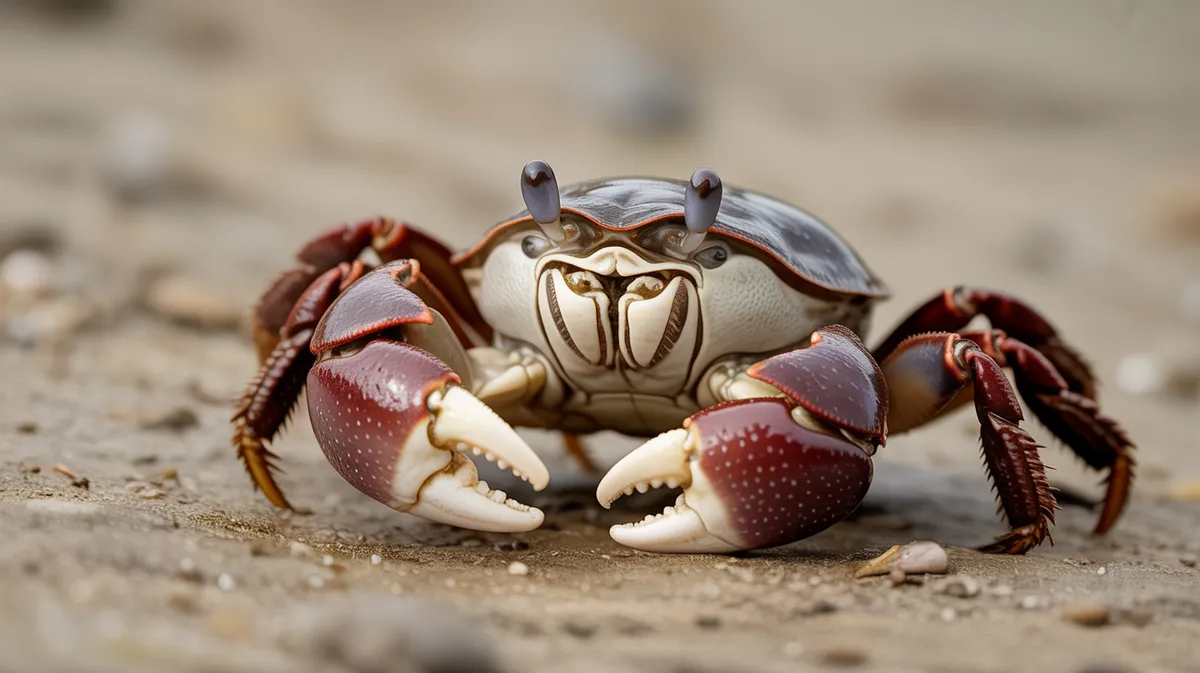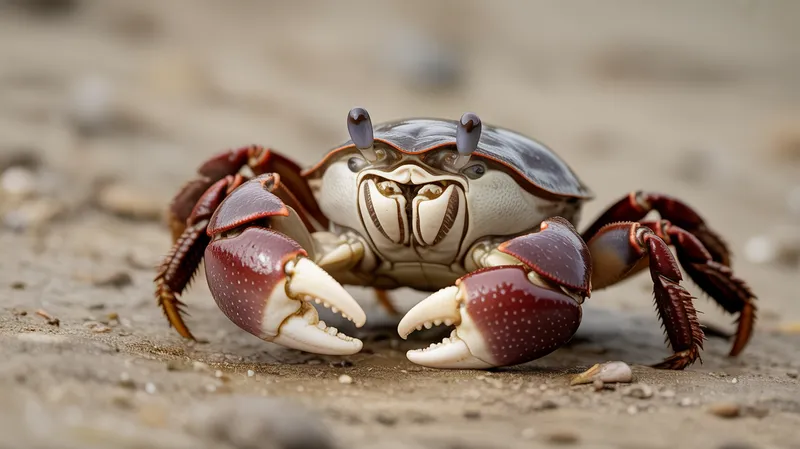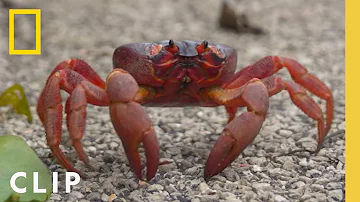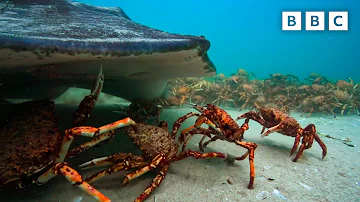
Atlantic mole crab
Emerita talpoida

Meet the Atlantic mole crab
The Atlantic mole crab is a small, burrowing crustacean commonly found along sandy beaches of the western Atlantic Ocean. Recognizable by its oval, domed body and lack of claws, this crab is an expert at digging backward into the sand, where it spends most of its life. It filters plankton and organic matter from the water using its feathery antennae, emerging at the edge of the surf to feed and reproduce. The species is vital to coastal ecosystems, serving as both prey for shorebirds and fish and as a key player in nutrient cycling.
Classification
Invertebrate
Habitat
Sandy intertidal zones along the Atlantic coast
Diet
Filter feeder
Lifespan
1-2 years
Conservation
Least Concern
Weight
1-3 grams
📖Fascinating Facts
Sand Dwellers
Atlantic mole crabs spend nearly their entire lives buried in the shifting sands of the surf zone, where they are well camouflaged from predators.
Surf Specialists
They use the motion of the waves to reposition themselves and to filter feed, timing their movements with the ebb and flow of the tide.
Egg Carriers
Females can be seen with vivid orange eggs attached to their bodies, sometimes numbering over 45,000 in a single brood.
📋Detailed Description
The Atlantic mole crab (Emerita talpoida) is a small, barrel-shaped crustacean, typically measuring between 1.5 and 3.0 centimeters in length, with females generally larger than males. Its body is smooth, oval, and highly domed, lacking the prominent claws (chelae) seen in many other decapods. The exoskeleton is pale gray to tan, often blending seamlessly with sandy substrates. Adapted for a fossorial lifestyle, E. talpoida burrows rapidly backward into the sand using its powerful, paddle-like legs and streamlined body. Its antennae are long and feathery, specialized for filter feeding; these are extended into the water column to capture plankton and detritus from the swash zone. The crab spends most of its life buried just below the surface, emerging primarily during tidal changes to feed and reproduce. It exhibits a remarkable ability to track and maintain its position within the dynamic intertidal zone, moving with the tides to avoid desiccation and predation. Social structure is minimal, as individuals do not form colonies but may aggregate in high densities where conditions are favorable. The species plays a crucial ecological role, serving as a primary food source for many shorebirds and fish, and contributing to nutrient cycling within sandy beach ecosystems.
💡 Did you know?
Despite being called 'crabs,' Atlantic mole crabs are more closely related to shrimp than to true crabs.
🔬Research & Sources
Wikipedia Summary
Emerita talpoida, known generally as the Atlantic mole crab or Atlantic sand crab, is a species of mole crab in the family Hippidae. It is found in the western Atlantic Ocean and Mexico along the shoreline.
Last Modified: 3/11/2025
🎭Behavior & Social Structure
Emerita talpoida is primarily active during periods of tidal movement, synchronizing its feeding and movement with the ebb and flow of the surf. It burrows backward into the sand with rapid, coordinated movements, often disappearing in less than a second when threatened. The crab positions itself with only its antennae and sometimes the tips of its uropods exposed, allowing it to filter feed efficiently while remaining concealed from predators. Feeding occurs by extending the feathery antennae into the water to trap suspended organic particles and plankton. The species is non-aggressive and solitary, with minimal direct interaction between individuals except during mating. Daily routines are governed by tidal cycles, with periods of feeding, burrowing, and occasional short-distance migrations up and down the beach face to maintain optimal moisture and oxygen levels. When disturbed, E. talpoida can rapidly rebury itself or, if dislodged by waves, use its legs to swim short distances before burrowing again.
👶Reproduction & Life Cycle
Reproduction in E. talpoida is seasonal, typically peaking from late spring through summer, although timing can vary with latitude. Mating occurs in the swash zone, where males grasp females using specialized appendages. Fertilization is internal, and females carry fertilized eggs attached to their pleopods (swimming legs) beneath the abdomen. The incubation period for eggs is approximately 2-3 weeks, depending on water temperature. Females can carry several hundred to over a thousand eggs per brood. Upon hatching, larvae are released into the water column as planktonic zoeae, undergoing multiple molts over several weeks before settling back into the sand as juvenile crabs. There is no parental care beyond egg brooding; larvae are entirely independent after release. High larval mortality is common due to predation and environmental factors.
🛡️Adaptations & Survival
Emerita talpoida exhibits several key adaptations for life in the high-energy swash zone. Its streamlined, domed body minimizes resistance when burrowing and helps prevent dislodgement by waves. The absence of claws reduces drag and allows for rapid backward digging. The feathery antennae are highly specialized for filter feeding, maximizing surface area for capturing food particles. Its legs are flattened and fringed, acting as effective paddles for both digging and limited swimming. The crab's ability to sense and respond to changes in water movement enables it to track the shifting swash zone, ensuring it remains in moist, oxygenated sand. Physiologically, E. talpoida can tolerate wide fluctuations in salinity and temperature, a necessity for survival in the intertidal environment. Its cryptic coloration provides camouflage from predators such as shorebirds and fish.
📚Research Sources
🎨Cultural Significance
While E. talpoida does not have significant direct economic or cultural value to humans, it is occasionally used as fishing bait, particularly for surf fishing targeting species such as striped bass and pompano. The species is often featured in educational programs about coastal ecology, serving as a model organism for teaching about intertidal adaptations and food webs. In some coastal communities, children collect mole crabs for observation and play, reflecting a minor but notable presence in local beach culture. There are no known mythological or symbolic associations with this species.
🔬Recent Research & Discoveries
Recent research on E. talpoida has focused on its role as a bioindicator for sandy beach health, with studies examining population responses to beach nourishment and pollution. Molecular studies have clarified its phylogenetic relationships within the Hippidae. Investigations into larval dispersal patterns have provided insights into connectivity among populations along the Atlantic coast. Ongoing work is assessing the impacts of climate change and human disturbance on its reproductive cycles and distribution. Notably, E. talpoida has been used in studies of intertidal zone hydrodynamics, as its burrowing and feeding behaviors influence sediment structure and nutrient cycling.
🎥Wildlife Videos

Perilous Red Crab Migration | Incredible Animal Journeys | National Geographic
Red crabs begin their march to the sea, overcoming predators and threats to lay their eggs. Enjoy a free trial of National ...
National Geographic

For Pacific Mole Crabs It's Dig or Die | Deep Look
Pacific mole crabs, also known as sand crabs, make their living just under the surface of the sand, where they're safe from ...
Deep Look

A Wildlife Odyssey - Southeast Asia's Island Paradise | Part 2 | Free Documentary Nature
A Wildlife Odyssey - Southeast Asia's Island Paradies | Part 2: Bewitched by the Moon | Wildlife Documentary Watch 'A Wildlife ...
Free Documentary - Nature

Facts: The Mole Crab
Quick facts about these tiny crustaceans that are fast burrowers! Mole crabs (Hippid mole crabs, Hippidae, sand crabs). Mole crab ...
Deep Marine Scenes

Mole Crab Caviar
Sea from Naturalistpodcast.com goes adventuring on an Oregon beach and finds a mole crab mystery...
The Naturalists

The incredible unity of the spider crab | Spy in the Ocean - BBC
Proof there's power in numbers! #SpyInTheOcean #iPlayer Spy in the Ocean is available on iPlayer in the UK and will be ...
BBC
🌍Habitat Information
The Atlantic mole crab typically inhabits Sandy intertidal zones along the Atlantic coast environments. Atlantic mole crabs have adapted to their environments with specialized features and behaviors.
Primary Habitat:
Sandy intertidal zones along the Atlantic coast
More detailed habitat information will be available soon.
🛡️Conservation Status
The Atlantic mole crab is currently classified as Least Concern. Conservation efforts are crucial for preserving this species for future generations.
Common Threats:
- 🏠Habitat loss and fragmentation
- 🌡️Climate change impacts
- 🎯Hunting and poaching
- 🏭Human-wildlife conflict
⚠️Threats & Conservation Challenges
Currently, the Atlantic mole crab is not considered threatened and is classified as Least Concern. However, it faces several localized challenges. Beach erosion, coastal development, and mechanical beach cleaning can disrupt or destroy critical habitat. Pollution, particularly oil spills and microplastics, poses risks to both adults and larvae. Climate change may alter tidal regimes and increase storm frequency, potentially impacting population dynamics. Despite these pressures, E. talpoida populations are generally stable due to their high reproductive output and wide distribution. Ongoing monitoring is needed to detect potential declines, especially in heavily developed coastal regions.
🔬Scientific Classification
Scientific Name
Emerita talpoida
Classification Hierarchy
🔍 About Taxonomic Classification
Taxonomic classification is a hierarchical system used by scientists to classify and organize living organisms based on shared characteristics and evolutionary relationships.
The system moves from broad categories (Kingdom) to increasingly specific ones, with each animal's scientific name typically consisting of its Genus and species.
📝Community Notes
Share your observations and insights about the Atlantic mole crab with our community of wildlife enthusiasts.
Join Our Community
Sign in to share your observations and connect with fellow wildlife enthusiasts.
Sign In to ContributeNo community notes yet
Be the first to share your observations about the Atlantic mole crab!
Explore Atlantic mole crab
Select a tab above to learn more about this amazing animal.
📸Photo Gallery
No photos available for this animal yet.
🌟Discover More Wildlife
Continue your journey of discovery with more fascinating animals from our database
